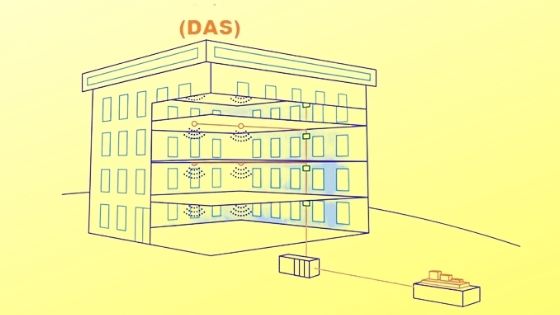We all know that cellular service providers offer as much support as possible to limitless subscribers who use apps such as films and other media. Small cell networks, on the other hand, are rising in popularity and are essential for providing the desired coverage and network capacity. As a result, many service providers rely on DAS antenna systems to supply outside network plans.


DAS solutions address not just the small-cell network delivery needs but also the backhaul. Besides, the best thing about DASs is they can be installed both indoors and outdoors.
DAS Overview
The distributed antenna system’s goal is to distribute power across several antenna units and provide equal coverage to all cellular devices. As a result, enhanced dependability and reduced power are assured.
In simple words, a distributed antenna system is a cluster of antennas that transmits the cellular signals at the licensed frequency of the carrier. As a result, end-users benefit from enhanced internet and voice connectivity. The two vital and basic components of DAS comprise:
- Signal Source: The role of DAS is to distribute the signals across the areas. However, the DAS itself does not produce the signals. It receives the signals for cellular towers and then sends them to the other receiving station or simply the small cells.
- Distribution System: When the receiver station gets the signal from the transmitting towers, the DAS distributes it across the building. Here, the implementation of DAS can take place utilizing the feeders or passive splitters.
Distributed Antenna System Types
Active DAS
The amplifiers in active DAS require installation at different antenna positions. Fiber cables can come into use to carry signals from the repeaters to the antenna sites. The amplifiers boost the signal from the repeater, giving wireless equipment a better signal.
They also rectify signals from wireless gadgets so that they may send out a more powerful signal. This DAS system can provide connectivity benefits to wide regions but comes with increased cost and complexity.
Passive DAS
The passive DAS comprises a signal source that is set to be connected to a repeater or amplifier. This cellular repeater further connects with the antenna across the premises using splitters, feeders, or coaxial cables. Besides, there is no rectification of signals among the distributed antennas and repeaters.
Hybrid DAS
This is the distributed antenna system that is the combination of both the active and passive systems. It uses fiber cables for signal distribution but mostly uses passive coaxial cables. There is no link or tie-up between the RRUs and antennas. As a result, both coaxial and fiber cables can be used for distribution throughout the facility.
Simply put, hybrid systems are a viable option for medium-sized spaces. Also, the spaces facing unusual signal problems can have hybrid DAS installed. In addition,
A fiber cable can connect multiple passive systems to a distant amplifier unit.
How Distributed Antenna System Functions?
The DAS antenna systems provide the best possible support to multiple carriers. The antenna in this system receives the signals and other access points. These signals further require transmission via optic cables to amplifiers. Afterward, the base transceiver station that delivers the data and phone calls within the building.
In addition, these systems provide better network coverage than you have experienced before provided by the standard cellular service providers. Further, the signals are split with the antennae nodes and then sent to varying antennas.
Omni-directional technology is the one that distributed antennas rely upon. This supports the transmission of signals in all directions simultaneously. Thus, achieving extended coverage and high connectivity.
The signals that each antenna receives need to be sent to the main hub. Both antennas cover the same region, and they operate together to create a reliable cellular system throughout the structure.
The best thing about the DAS is its nodes are easily configurable as per the needs. Also, the installation of DASs is hassle-free without disrupting any operations.
Where Can Distributed Antenna Systems Be Installed?
Distributed Antenna Systems are of more help when installed in places like schools and colleges. Digital DAS delivers high-quality wireless signals that the students can use to browse the necessary data, perform research, and complete assignments.
Also, the DASs are available in almost all hospitals across the world. It enables the healthcare service providers to have access to proper network coverage and data speeds. Similarly, airports can install such improved network connectivity solutions. This will ensure better signal reception across the terminals.
No matter where you reside, the distributed antenna system is an ideal solution to avoid poor calls, connectivity issues, and more. Be it office, warehouse, airport, or another place, improving wireless coverage is easy with distributed antenna systems.
Benefits of Distributed Antenna Systems (DAS)
Below are the advantages of installing a distributed antenna system and the reasons why most businesses or residential spaces have DAS instead of smart cells.
- Capacity: DAS can manage available resources while precisely aligning signal strength as per the market demand.
- Data: Distributed antenna systems provide better cellular connectivity to the user devices.
- Interference: DAS reduces any internet connectivity hassles via low radiation centers and lower output power.
- Coverage: DAS architecture provides coverage in areas with low signal strength.
- Scalability: This scalable network allows the addition of multiple nodes to meet the future signal capacity demands.
- Spectrum: DAS uses all the known frequency spectrum efficiently.
Summing Up
All in all, the use of the DAS is going to expand globally in terms of delivering the best possible network connectivity. Big spaces that need the maximum network coverage possible can benefit from distributed antenna systems. It can reliably connect a huge number of people in a limited geographic region.
So, now is the time to contact specialists to explore such a solution and have it installed on your premises for improved network coverage.
















